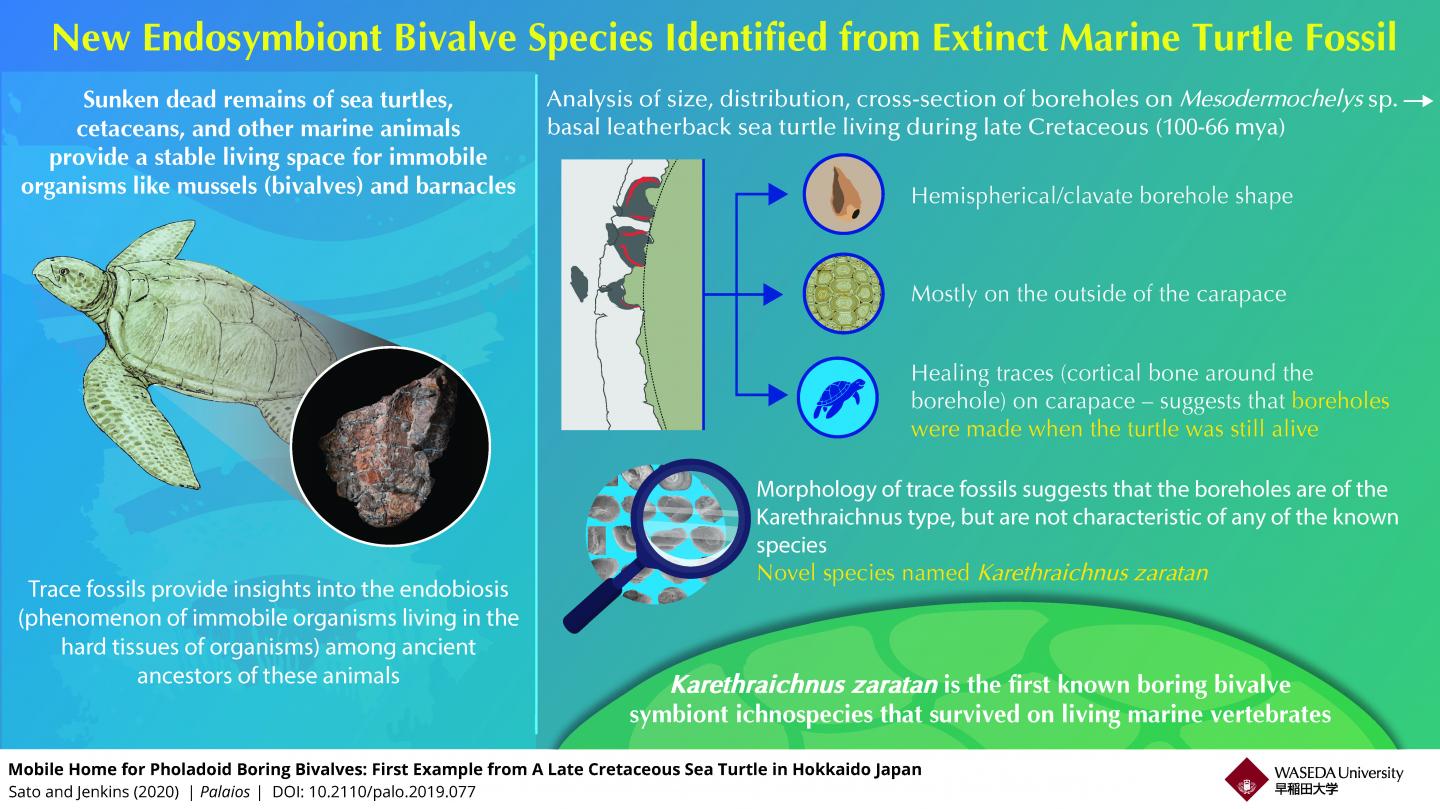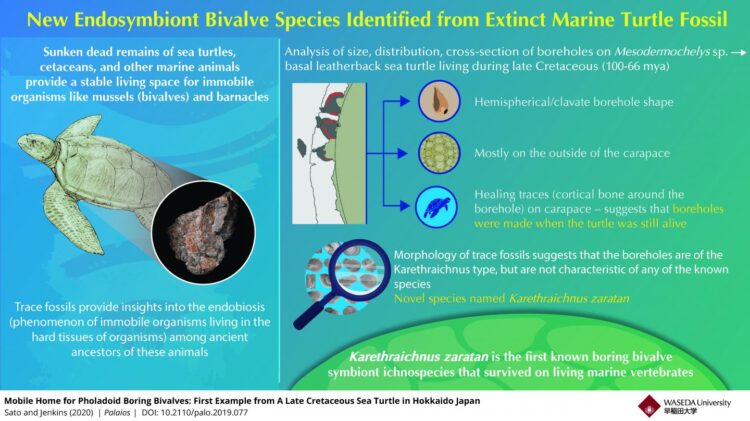Scientists identified a new ichnospecies from the shell of an extinct marine turtle fossil, the first known species coexisting on living marine vertebrates

Credit: Waseda University
While paleontologists have a wealth of vertebrate fossils at their disposal, their knowledge of the ecology of ancient extinct species, particularly regarding their relationship with invertebrate species, is relatively poor. As bones and hard shells “fossilize” much better than soft tissues and cartilage, scientists are limited in their ability to infer the presence of parasitic or symbiotic organisms living in or on these ancient vertebrates. As a result, relatively little is known about the evolutionary relationships between these ancient “clades” and their modern descendants.
All hope is not lost, though, as researchers can infer the presence of these small organisms from the footprints they left behind. These records are called trace fossils, or ichnofossils. One clear example of such ichnofossils is the boreholes that many mollusks make in the turtle shell remains and whale and fish bones on the ocean floor. However, to this date, there have been no indications that such species also lived in the shell while the turtle was alive and well.
In their recent study published in the journal Palaios, Assistant Professor Kei Sato from Waseda University and Associate Professor Robert G Jenkins from Kanazawa University focused on the trace evidence left on the carapace (shell) of an extinct basal leatherback marine turtle (Mesodermochelys sp.). The fossil was recovered from an Upper Cretaceous formation in Nio River, Japan, and the evidence in question were 43 tiny, flask-shaped boreholes all over the turtle shell fossil.
Eager to learn more about the organisms responsible for this, the scientists formulated a hypothesis, based on previous borehole evidence found on ancient marine turtle shells. After observing the fossil up close and measuring the morphological characteristics of the boreholes (see Figure), they produced a 3-dimensional reconstruction of the carapace and the cross-section of one of the boreholes, which allowed them to observe the intricate details left by the species.
Sato, who is the lead author of this study, elaborates on the surprising evidence they found, “We saw that there were signs of healing around the mouth of boreholes, suggesting that the turtle was alive when the organisms settled on the carapace.” Based on the morphology and positioning of the boreholes, they determined that the likely culprits for these boreholes were “bivalves” from the superfamily Pholadoidea, creatures similar to the modern clams. These “sessile” (or immobile) organisms normally require a stable substrate to bore into, and the turtle carapace was a suitable host. The fact that the host animal was swimming around freely probably helped, as this allowed exposure to new environments.
Sato and Jenkins identified the boreholes called Karethraichnus; however, they were unable to match the characteristics of the boreholes they found with those made by any currently described species. This only meant one thing: that they had stumbled onto a completely new species! They have accordingly named this new species as Karethraichnus zaratan.
Sato is excited about the implications of their findings, stating, “This is the first study to report this unique behavior of boring bivalves as a symbiont of living marine vertebrate, which is a significant finding for the paleoecology and evolution of ancient boring bivalve clades.” Previously, no such species had been shown to live on the carapace of living vertebrates. Instead, they were often reported to occur on the remains of marine turtles and other vertebrates, laying on the ocean floor alongside various decomposing organisms. By attaching themselves on a live, free-swimming substrate, such as the carapace of a marine turtle, these pholadoid bivalves may have paved the way for a novel, yet-unknown evolutionary path of accessing previously unexplored niches and diversifying into new species. As the tracemaker bivalves of Karethraichnus zaratan are considered to belong to one of the basal groups for Pholadoidea, this knowledge is crucial for understanding the evolutionary history of extant organisms in this group.
Reference
Authors: Kei Sato and Robert Jenkins
Title of original paper: Mobile home for pholadoid boring bivalves: first example from a late Cretaceous sea turtle in Hokkaido, Japan
Journal: Palaios
DOI: 10.2110/palo.2019.077
Affiliations: (1) Waseda University, Nishiwaseda, Shinjuku-ku, Tokyo, 169-8050, Japan. (2) Kanazawa University, Kakuma, Kanazawa, Ishikawa, 920-1192, Japan.
Media Contact
Jasper Lam
[email protected]
Original Source
https:/
Related Journal Article
http://dx.





